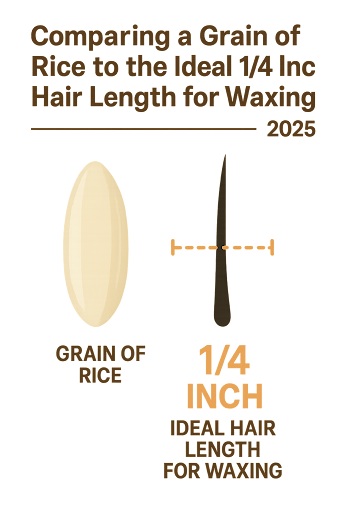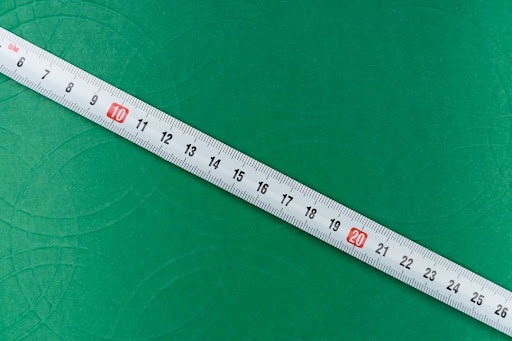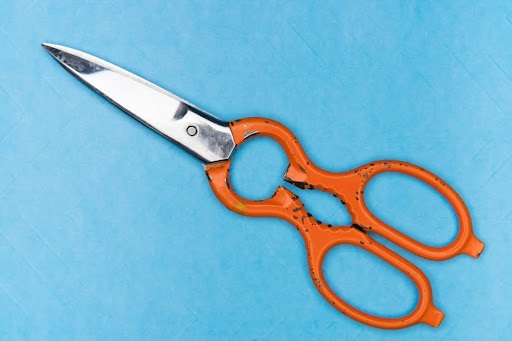The “Goldilocks Zone”: Why Hair Length is Crucial for Waxing

Many of us want smooth, hair-free underarms. Shaving can lead to stubble and irritation too quickly. Waxing offers a popular alternative for longer-lasting results.
However, successful waxing depends on one key factor. That is the length of your underarm hair. If it’s too short, the wax won’t grip properly. If it’s too long, the process can be more uncomfortable.
In this guide, we will explore the perfect armpit hair length for waxing. We will explain why this specific length is so crucial. We will also cover preparation tips and the many benefits of getting it right. Our goal is to help you achieve the smoothest underarms possible.
Just like Goldilocks searching for the perfect porridge, there’s an ideal “just right” length for armpit hair when it comes to waxing. This optimal length is typically around 1/4 inch, which is roughly the size of a grain of rice. This seemingly small detail is paramount for a successful and comfortable waxing experience.

The reason this specific length is so critical lies in the mechanics of waxing. Wax works by adhering to the hair, not the skin. When the hair is at the ideal 1/4 inch, the wax can effectively encapsulate each strand, allowing for a strong grip. This strong grip is essential for pulling the hair directly from the follicle, removing it from the root. Removing hair from the root is what delivers that coveted smooth finish and significantly slows down regrowth.
If the hair is too short, the wax won’t have enough surface area to grab onto. This leads to ineffective removal, where hair either breaks off at the surface or the wax simply slides over it, leaving you with patchy results. Conversely, if the hair is too long, it can become tangled in the wax, leading to increased discomfort, uneven removal, and a higher risk of skin irritation. The correct length ensures that the wax adheres perfectly, allowing for clean, efficient removal with minimal discomfort. Understanding and achieving the correct armpit waxing length is the first step towards a truly effective hair removal routine. For those considering professional armpit waxing, knowing this optimal length ensures you arrive prepared for the best possible outcome.
What Happens if Underarm Hair is Too Short?
When your underarm hair is too short for waxing, typically less than 1/4 inch, it presents a significant challenge for the wax to properly adhere. Imagine trying to pick up tiny, slippery objects with a sticky surface – it’s difficult, and often, you’ll miss more than you catch. The same principle applies to waxing.
The primary consequence of hair being too short is ineffective removal. The wax simply won’t have enough length to grip the hair firmly. This results in the hair breaking off at or just below the skin’s surface, rather than being pulled from the root. This “hair breakage” means you’ll be left with immediate stubble, defeating the purpose of waxing for long-lasting smoothness. Furthermore, these broken hairs can become trapped beneath the skin as they regrow, leading to a higher incidence of painful and unsightly ingrown hairs.
Beyond unsatisfactory results, waxing hair that is too short can also lead to skin irritation. When the wax can’t properly grip the hair, the pulling action can tug at the skin unnecessarily without effectively removing the hair. This can cause redness, tenderness, and even minor abrasions, making the experience more painful than it needs to be. It leads to wasted effort, as you won’t achieve the desired smoothness, and you’ll likely need to reschedule your appointment or resort to other hair removal methods sooner than anticipated. This is why we always emphasize the importance of proper hair length for effective armpit hair wax removal.
What Happens if Underarm Hair is Too Long?
While “too short” is a common concern, hair that is “too long” can also pose problems for underarm waxing, particularly if it exceeds 1/2 inch. While it might seem intuitive that longer hair would be easier to grip, this isn’t always the case with waxing.

The most immediate consequence of overly long underarm hair is increased pain and discomfort. When the wax is applied to very long hair, it can pull and tug at the skin more intensely, and the hair can tangle within the wax, leading to a more painful removal process. The long hairs can also cause the wax strip to lay unevenly, resulting in an inconsistent pull that can be less effective and more painful. This is especially true for sensitive areas like the underarms.
Furthermore, overly long hair can lead to uneven results. The wax might not be able to evenly coat all the strands, or some hairs might get matted down rather than standing upright for optimal removal. This can result in patchy areas where some hair is removed and some is left behind, requiring additional applications or cleanup, which can further irritate the skin. In extreme cases, very long hair can increase the risk of skin lifting, where the top layer of skin is removed along with the wax, leading to raw, sensitive areas. To avoid these issues, professional waxers often recommend trimming excessively long hair before the appointment. While it’s rare for hair to be “too long” for a first wax, subsequent waxes benefit greatly from maintaining the ideal length.
Preparation and Timing for Your Blissful Spa Armpit Waxing Length
Achieving the perfect armpit hair length for waxing is not just about waiting for it to grow; it’s about understanding your body’s natural hair growth cycle and timing your waxing appointments strategically. All hair on our body goes through three main phases: Anagen (the active growth phase), Catagen (a transitional phase where growth stops), and Telogen (the resting phase, after which the hair sheds). For waxing to be most effective, we want to remove hair during its active growth phase (Anagen), as this pulls the hair directly from the root, leading to longer-lasting results and potentially finer regrowth over time.
Understanding these hair growth stages helps us grasp why consistent waxing is key. Not all hairs are in the same growth phase at the same time. When you wax regularly, you gradually encourage more hair to enter the same growth cycle, leading to more synchronized regrowth and ultimately, smoother results for longer periods. This consistency is vital for optimizing your waxing experience and maximizing the benefits of armpit waxing.
How to Achieve the Perfect Blissful Spa Armpit Waxing Length
The timeline for achieving the perfect Blissful Spa armpit waxing length of 1/4-inch depends largely on your previous hair removal method.
If you’ve been shaving, your hair will typically need about 2 to 3 weeks of growth to reach the ideal length for waxing. This period allows the hair to emerge fully from the follicle and become long enough for the wax to grip effectively. It’s crucial to resist the urge to shave during this grow-out period, as even a quick shave can reset the clock and delay your waxing appointment.
If you’ve been waxing consistently, your hair growth cycle will likely be more synchronized, and you’ll typically be ready for your next appointment in about 3 to 4 weeks from your last wax. This is because waxing pulls hair from the root, and it takes longer for new hair to grow back to the surface.
Hair growth rates vary significantly from person to person. Factors such as individual genetics, hormonal fluctuations, diet, and even age can influence how quickly your hair grows. While 1/4 inch is the general guideline, some individuals may find their hair reaches this length faster or slower. We recommend observing your own hair growth patterns to determine your optimal waxing schedule. Our experts can also provide personalized advice on how long does an armpit wax last for your specific needs, helping you maintain that smooth feeling for as long as possible.
Trimming and Pre-Wax Prep for the Perfect Blissful Spa Armpit Waxing Length
Sometimes, despite our best efforts, underarm hair can grow longer than the ideal 1/2 inch. In such cases, a slight trim might be necessary before your waxing appointment to ensure the best results and minimize discomfort.

For trimming, we recommend using safety scissors with rounded tips or an electric trimmer with a guard. If using scissors, be extremely cautious and trim the hair to approximately 1/2 inch. Avoid trimming it shorter than 1/4 inch, as this could make it too short for the wax to grip. If you’re unsure or uncomfortable trimming yourself, many professional waxing salons offer trimming as part of their service. It’s always better to arrive with hair that’s a little too long than too short, as a professional can easily trim it to perfection.
Beyond trimming, proper pre-wax preparation is vital for a smooth experience. We advise performing a gentle exfoliation of your underarms 24-48 hours before your appointment. You can use a mild sugar scrub, a soft washcloth, or a dry brush in gentle circular motions. This crucial step not only removes dead skin cells that can clog pores but also helps to ‘lift’ the hairs away from the skin. This ensures the wax grabs the hair itself, not the skin, and clears a path for new, finer hairs to grow out properly, significantly reducing the risk of painful ingrown hairs post-wax. On the day of your appointment, ensure your skin is clean and dry. Avoid applying deodorant, antiperspirant, or lotions to the area, as these can create a barrier that prevents the wax from adhering properly. Antiperspirants, in particular, often contain aluminum-based compounds designed to plug sweat ducts, which can severely compromise the effectiveness of the wax. Arriving with clean, product-free skin is non-negotiable for a successful session. Finally, wear loose clothing to your appointment to prevent friction and irritation on your freshly waxed skin. Following these simple steps ensures you’re ready for a successful and comfortable waxing session.
Waxing vs. Shaving Underarms: A Detailed Comparison
When it comes to underarm hair removal, the two most popular methods are waxing and shaving. While both aim to achieve smooth skin, they differ significantly in their approach, results, and overall impact on your skin and hair growth over time. Understanding these differences can help you make an informed decision about which method is best for you.
Feature Waxing Shaving Method Warm wax is applied and removed with a strip, pulling hair from the root. A razor blade cuts hair at the skin’s surface. Longevity Results last 3-6 weeks as hair is removed from the follicle. Results last 1-3 days as hair is only cut at the surface. Regrowth Hair grows back finer, softer, and often sparser over time. Hair grows back with a blunt, stubbly feel. No change in thickness. Pain Level Moderate discomfort during the pull, which subsides quickly. Pain lessens with regular sessions. Generally painless, unless nicks or cuts occur. Skin Health Exfoliates dead skin cells. Risk of irritation, redness, or ingrown hairs if not done properly. High risk of razor burn, nicks, cuts, and irritation. Can dry out the skin. Cost Higher upfront cost per session, but less frequent. Lower upfront cost for razors and cream, but ongoing expense. Time Quick professional sessions every 3-6 weeks. Requires grow-out time. Can be done daily or every few days as part of a shower routine. Longevity and Regrowth
The most significant advantage of waxing is the longevity of the results. By removing hair from the root, you get weeks of smooth skin, not just a day or two. Over time, this process can damage the hair follicle, causing regrowth to become noticeably finer and sparser. In contrast, shaving simply slices the hair at its thickest point on the skin’s surface. This is why stubble appears so quickly—often within 24 hours—and feels coarse to the touch. Shaving does not affect the rate or texture of hair growth in the long term.
Skin Health and Sensation
While waxing involves a moment of pain, many find it preferable to the chronic irritation of shaving. Shaving drags a sharp blade across the delicate underarm skin, often leading to micro-abrasions, razor burn, and painful nicks. Waxing, when performed correctly, acts as a powerful exfoliant, removing the top layer of dead skin cells for a brighter appearance. However, improper technique or poor aftercare can lead to temporary redness, sensitivity, or ingrown hairs. Shaving, on the other hand, offers a higher daily risk of irritation and provides no exfoliating benefit.
Cost and Convenience
From a cost perspective, shaving appears cheaper initially. A pack of razors and shaving cream costs less than a single professional wax. However, these costs are recurring and add up over time. Waxing is an investment in less frequent maintenance. While a professional session has a higher upfront cost, you only need it every 3 to 6 weeks. The convenience factor is subjective. Shaving is quick and can be done at home daily, but waxing eliminates the daily chore of hair removal, freeing up time in your morning routine and providing peace of mind on vacations or during busy weeks.
